Indian restaurant bhuna curry is a recipe that shows up all on menus all over the place. It’s typically a thick, well spiced, medium hot dish. It’s really tasty. This bhuna is just that.
There’s no real guideline other than that. That’s why it’s so different from restaurant to restaurant. Kind of like balti in the UK.
Bhuna is the mystery curry
I think bhuna varies so much in restaurants because technically it’s not a dish. It’s a way of cooking. By definition spices are gently fried and then meat is added.
The whole thing is left to stew in it’s own juices. At the end, you wind up really big flavours and not a lot of sauce. Super concentrated curry.
I’ve looked at quite a few definitions of bhuna and it seems to come down to a curry with onions, garlic, tomatoes, chilies and spices.
That’s what this Indian restaurant bhuna curry recipe is all about.
I hope the curry police don’t come and take me away for misleading people with this post.
Or worse yet, take away my spices and condemn me to cooking curry with pre-fab curry powder for the rest of my life.
This is a master Indian restaurant bhuna curry recipe. You can make it with pre-cooked chicken, lamb, beef or use paneer, pre-cooked potatoes or eggplant for vegetarian options.
Bloom the spices in oil
Enough oil to fry the spices. That is a fundamental rule to Indian restaurant style curries. You can’t get around it. Too little oil and your spices will stick. They will burn. Not good.
It may seem like a lot of oil but it’s necessary. I’ve tried rolling back on it. It doesn’t work. Pretty much guaranteed to fail.
And frying spices is what makes bhuna curry what it is. Any curry really. It’s worth the extra calories.
Prep is key for Indian restaurant style curry cooking
Do your prep. That’s important. Make your curry base and have some heated and ready to go. Pre-cook your meat.
Measure out your ingredients. Have everything ready. Put on an apron – a bit of splatter is part of the fun.
If you have not yet read the guide to Indian restaurant technique yet, do it now. It has pictures to help you understand the recipe. There’s a video there so you can see for yourself. And a guide to Indian ingredients in that post.
Indian restaurant bhuna curry. It may not trace it’s roots back to a famous Indian dish but it delicious. And that’s really all that matters…
indian restaurant bhuna curry
Ingredients
The spice mix
- 2 tsp indian restaurant spice mix or curry powder - recipe link below
- 1 tsp kashmiri chili powder or 1/4 tsp cayenne mixed with 3/4 tsp paprika
- 1 tsp paprika
- 1 tsp kasoor methi
- 1/2 tsp kosher salt
The curry ingredients
- 3 Tbsp oil
- 1/2 onion coarsely chopped
- 2 green chilies seeded and diced (or thinly sliced if you want a bit of extra heat from the ribs)
- 1 Tbsp cilantro stems minced
- 1 Tbsp garlic/ginger paste - recipe link below
- 2 Tbsp tomato paste with enough water to dilute to the consistency of pasatta
- 15 oz curry base - recipe link below
- 10-12 oz pre-cooked chicken or lamb
- 1 Tbsp tamarind sauce - I use Maggi brand
- 3-4 cherry tomatoes - cut in half
Instructions
- Make the spice mix.
- Dilute the tomato paste with enough water to get to the consistency of passata.
- Heat your frying pan (don't use non-stick) briefly over medium heat. Add the oil.
- When the oil starts to shimmer add the onions and stir constantly until the edges of the onions start to brown. This takes about a minute.
- Next comes the garlic ginger paste. Add it into the pan and cook it, stirring constantly, until it stops sputtering.
- Add the green chilies and cilantro stems. Cook about 15-20 seconds.
- Turn down the heat and add the spice mix. This is the critical step. Stir it constantly for 30 seconds. If it starts to darken lift the pan off the heat. You want the spice mix to cook in the oil but not burn.
- Turn the heat up to medium high. Add the diluted tomato paste and stir until bubbles form (the oil will likely separate). This takes around 30 seconds to one minute depending on the heat.
- Add 3 oz of curry base. Stir until bubbles form (little craters really), around 30 seconds. Watch the edges of the pan. The curry can stick here.
- Now add 6 oz of curry base and stir briefly. Let it cook until the bubbles form again. This takes 1-2 minutes.
- Add the rest of the curry base and let cook until the bubbles form. Add the tamarind sauce. Turn the heat down to low and add the pre-cooked lamb, beef, chicken, tofu or vegetables.
- Let the curry simmer for about 5 minutes. If it gets too thick add a bit more curry base. Don't add water. Add the cherry tomatoes for the final 2-3 minutes of cooking.
- Garnish with a bit of chopped fresh cilantro and serve.
Notes
Nutrition

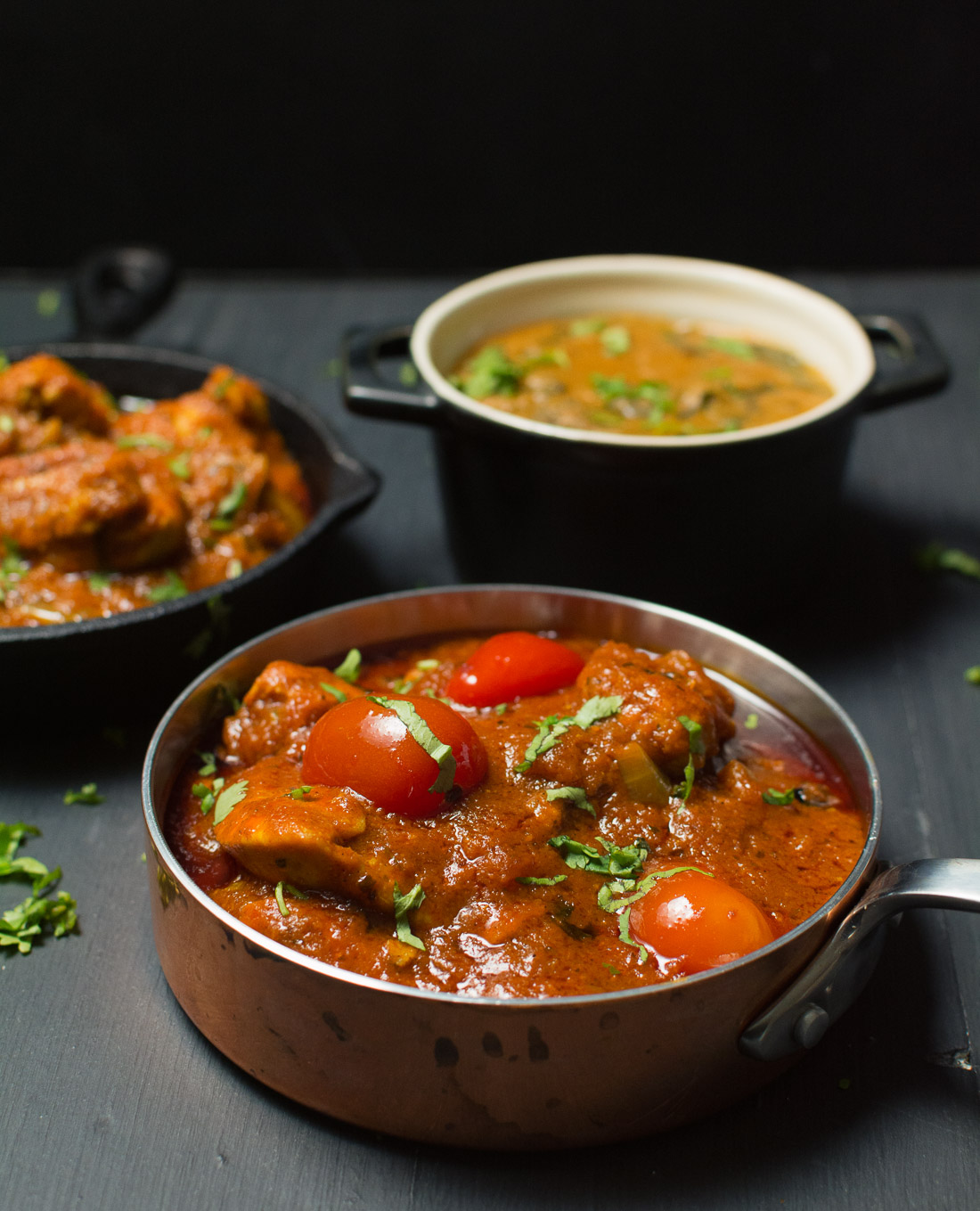
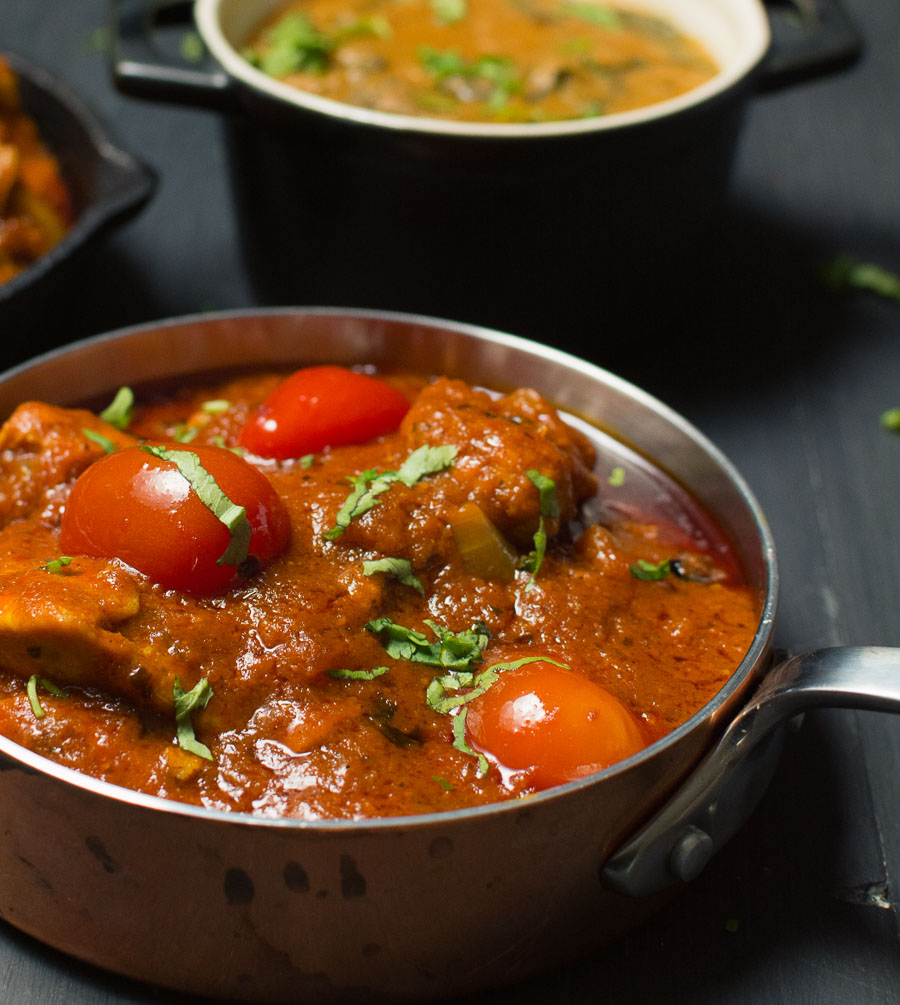
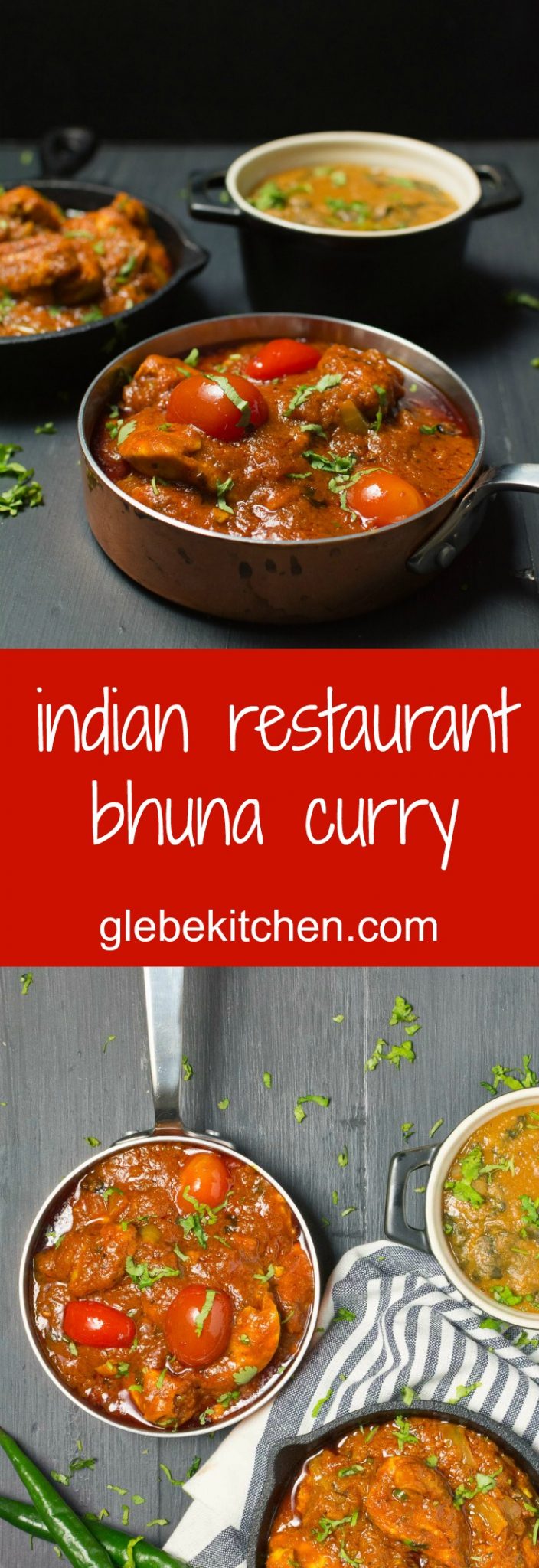
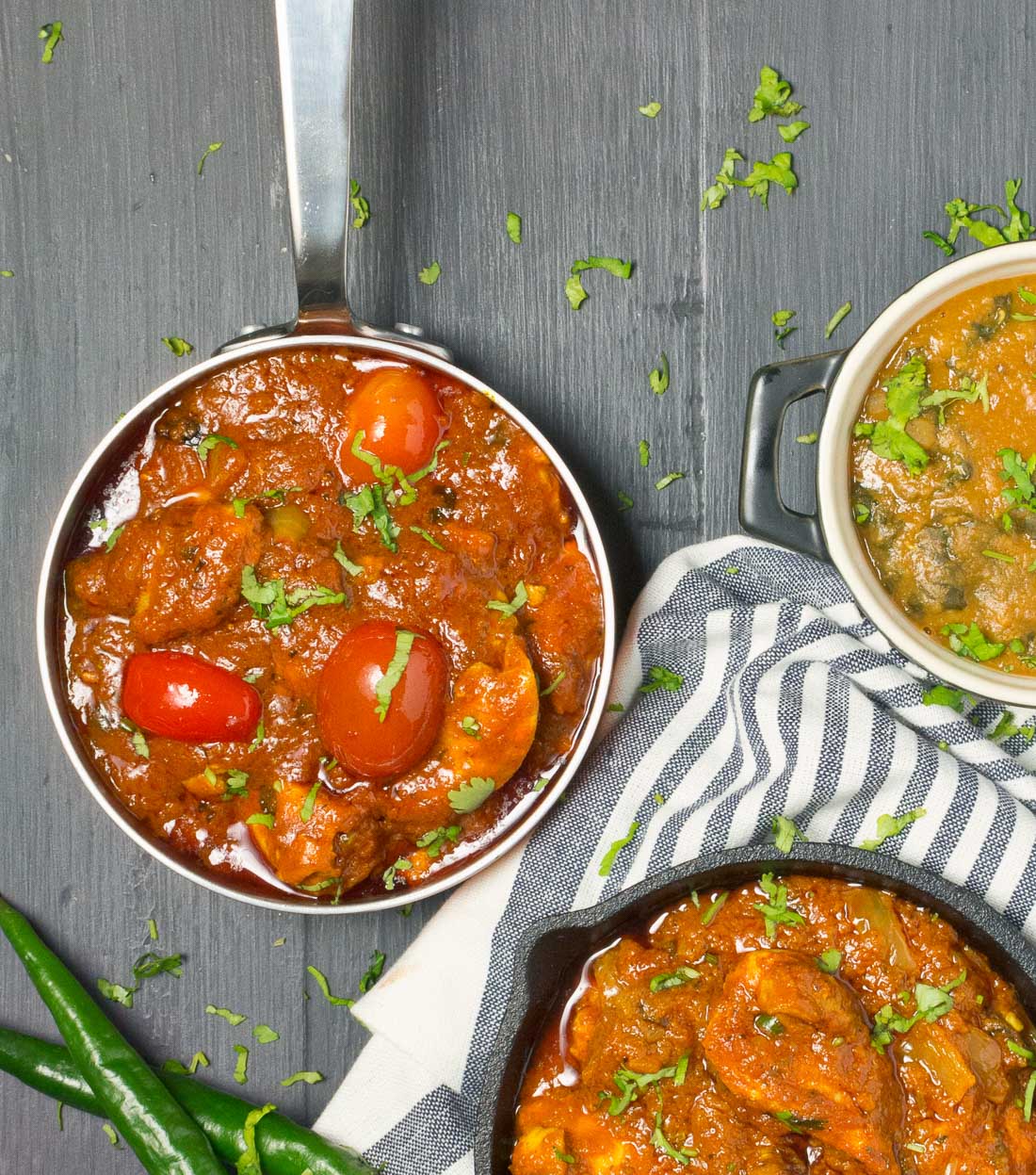
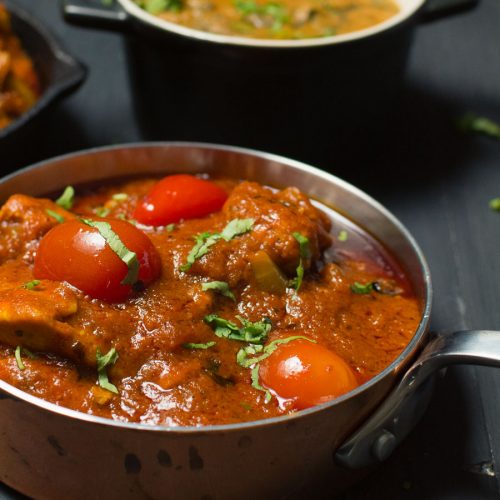
Great recipe The best I’ve made by some margin Followed the recipe to the letter other than I fried two star anise along with the onion and removed them near the end as I know from experience I’m a sucker for those background notes
Glad you liked it and love that you are making it your own!
Can I just say that lockdown has done one amazing thing and that is introducing me to Amazing recipes for curries like this Bhuna! When I order from a local takeaway in Birmingham I’ve always had Lamb Bhuna. Since I’ve found this recipe will be cooking my own from now “WOW”
Thank you for introducing me to your cook book and look forward to more to come. I’ve just got to master Samosas and I’m set for life. So if anybody out there can help because the flour I buy is expensive but is there a cheaper alternative I can. buy….?
Thank you
I’ve cooked the Lamb Bhuna Curry OMG it’s the best Curry I have ever cooked at home it was amazing. The only criticism I have is cooking the Lamb separately is good but don’t cook to long as I did. I also added potato to mine with Lamb and simply AMAZING!
Curry spices & Curry base made all the difference to the end product.
Thank to Glebe for this Curry will never buy one again brilliant 👍🏻
Absolutely delighted to hear that!
So last night i attempted my first ever homemade curry from scratch, and followed your advice to the letter. Made the Curry base, the ginger garlic paste, the spice mix, pre-cooked the meat, and i have to say it turned out amazing! As good or better than anything i have ever had in a restaurant. I am still highly impressed with myself, but really all i did was follow your instructions, so thank you! It was a lot of work and took me 3 hours of hard graft(plus a trip to the Indian grocers), but now i have loads of left over curry base etc, the next ones will be a cinch. Well worth the effort. My girlfriend now thinks i am genius.
That is just so awesome. I’m absolutely delighted to hear that! It’s real work getting started but once you’re past that it’s much easier.
Made this curry again…ditched the Natco GM and went with the East End brand…And yes we’re back on song. Having a curry night this weekend and this dish along with your delicious Jalrazi. Can’t wait to impress my friends thank you once again. BTW I also tried Pilau rice Perfect! I swear my friend will insist on me taking a lie detector as they will not believe that these dishes are not from the restaurant. Your a star Romain
Fantastic to hear! Sounds like you are killing it!
Hi Romain
I made my spice mix exactly the same as before. but I used a different brand (1st time East End) (2nd time Natco) and its changed the flavour of the spice mix and the Garam Masala is completely overwhelming the flavour. I though I had done it wrong so i made a smaller batch and the same thing happened!
I went back to using East End on the (Garam Masala only!) and I got the taste back. So I now have a huge tube of spice spoiled by the GM can I do anything to counteract the taste or shall I just throw it away?
Many Thanks
Veronica
That’s a shame. If it doesn’t taste right I just wouldn’t keep it around. No sense risking dinner over a few spices.
I’ve just cooked this curry. I followed the ingredients and methods to the letter – Made the curry gravy, Indian spice mix, Garlic & Ginger. Then set about making the curry. We ALL agree it was like eating at the restaurant, I’m still in shock at how authentic it tasted – Thank you-I’m hooked and a fan, I’ll be singing your praises!!
I’m so happy to hear this! It’s a bit daunting getting started on restaurant style curries but now you’ve taken the first step it gets much easier. You can freeze your base in curry size portions so you can make curries easily any time you want.
Hi Romain.
We’ve tried several of your Indian Restaurant Style dishes and find them very, very tasty; with easy to follow recipies.
However, we are cooking for three hungry adults and are struggling to scale up the spices & gravy ratios to suit 750g of meat for different recipies.
What advice can you offer please?
Looking forward to trying out further dishes.
Steve
It’s a tricky one. What I usually do is make dish twice. But you could make the sauce twice (right up to the point but before you put the chicken in). I’d transfer the first batch to a sauce pan, repeat and then put the chicken in the pot to warm through. I’d then add whatever finishing touches are needed.
If you really just want to scale the recipe I would try maybe doubling whole spices, 1.75x powdered spices (except any chili powder which I would just double). Salt I would go 1.5x Use a larger skillet and maybe 1.5x the oil. Add the base 4 times, instead of three and taste your curry at the end and adjust salt.
No guarantees it will be exactly the same. You may need to tinker a bit. Or you could look at my new series on hotel style curries. That will double nicely (again, be careful with the salt).
I’ve generally found restaurant Bhuna’s to be a bit weak but this is much more flavourful. As with most of my cooking, I do like to up the heat a bit though.
Don’t do what I did and use tamarind paste in place of sauce – unless you water it right down! I ruined my first go at this. Second time around it was delicious 🙂
Bhuna is such a fuzzy term anyway. It can mean almost anything. Glad you liked this one!
And everyone pay attention to the difference between tamarind paste and tamarind sauce. They are very different things…